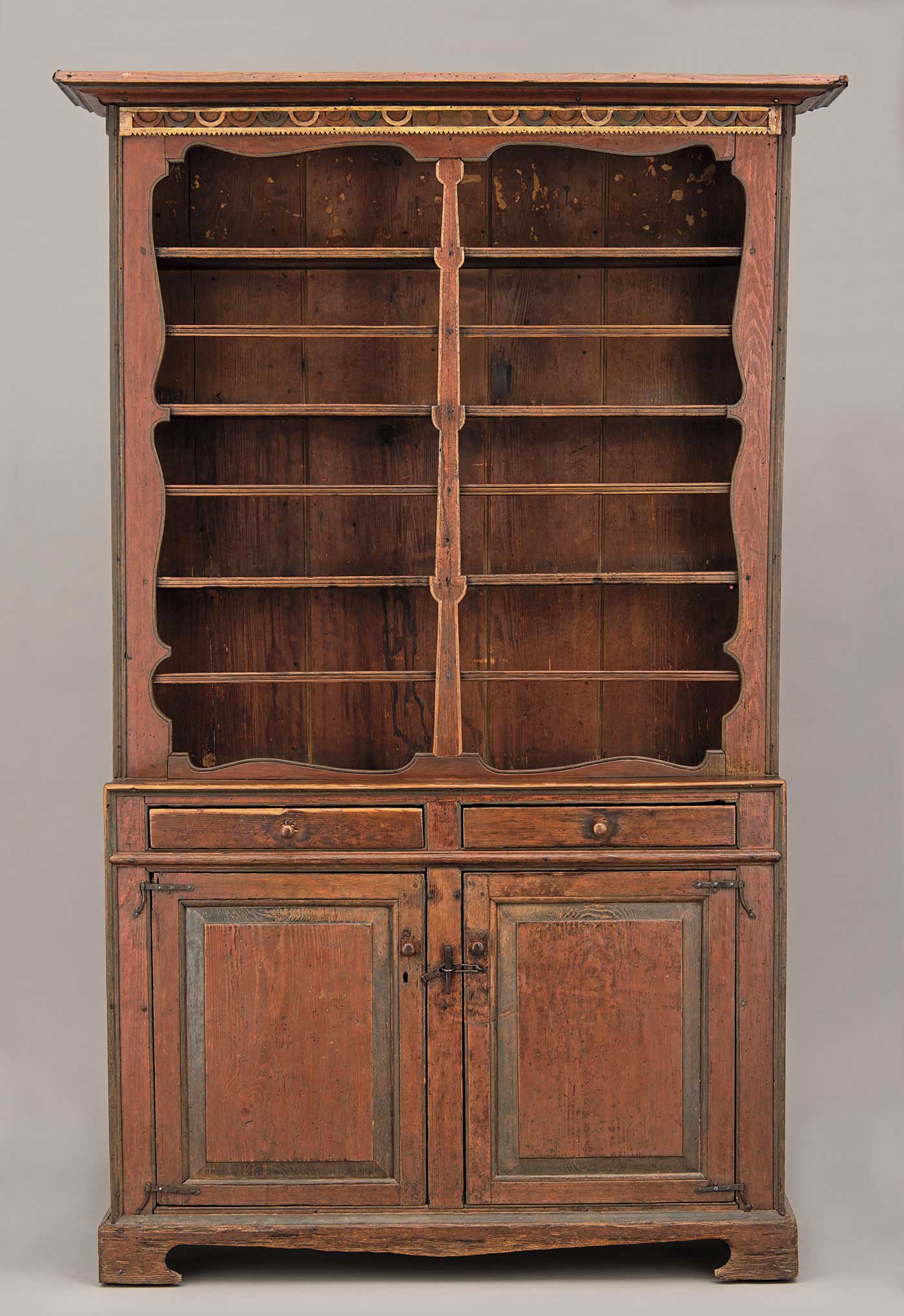Not all Southerners supported the Confederacy. The Civil War brought not only violence between Northerners and Southerners but also clashes between classes, including between wealthy slaveholders and yeoman farmers. This dresser’s probable maker, Jacob L. Saunders (sometimes spelled Sanders), was a casualty of one such clash. Saunders was killed in North Carolina by deserters from the Confederate army.
A “dresser” in the 18th and 19th centuries did not refer to bedroom furniture. Rather, as Samuel Johnson explained in his 1755 A Dictionary of the English Language, it was “the bench in a kitchen on which meat is drest or prepared for the table.” This dresser, which was made around 1820, was also used for displaying ceramic and metalware, as can be evinced from several front-mounted plate rails that would hold and tip large dishes forward to show off their ornamentation. The drawers and doors below probably stored pots, pans and table linens.
The display of ceramic and metalware showed off its owner’s taste and status, and the dresser itself was a colorful work of art. Its body retains some of its original red stain. Other parts were painted in white and Prussian blue. The ornate stiles and rails that frame the upper shelves are further signs that this dresser was meant to be admired.
Jacob L. Saunders’ death was part of a larger pattern of violence in the region. Far from being united in support of the Confederacy, Montgomery and nearby Randolph and Moore counties were deeply divided. Some who supported the Union did so because they were pacifists (the area was known as the Quaker Belt). Others did so because they resented what they considered a rich man’s war.
Probably the best-known uprising against the Confederacy took place in Mississippi and was made famous by the 2016 movie Free State of Jones. Overall, though, more soldiers deserted the army in North Carolina than in any other state. Some 23% of the state’s more than 22,000 soldiers abandoned the Confederate army. Bands of deserters, including one led by a Bill Owens, roamed the state. The Feb. 27, 1864, issue of The Daily Confederate of Raleigh reported that it was Owens’ men who killed Saunders. The newspaper reported that deserters went to the house of Pleasant Simmons (sometimes spelled Simons) in Montgomery County, demanded bacon and then broke down the door to Simmons’ smokehouse and began to eat. When Simmons and Saunders, who was visiting, protested, the deserters ordered them into Simmons’ house.
“They went back,” The Daily Confederate’s correspondent reported, “but Mr. Sanders got a gun and repeater from Mr. Simons and went out armed, when the wretches fired on them, killing Mr. Sanders and mortally wounding Mr. Simons. Mr. Sanders fired twice or three times before he expired, and it is believed he killed the noted Bill Owens, and probably one other. Mr. Sanders died in fifteen minutes; Mr. Simons survived some twenty-four hours.”
After describing the bloody scene, the newspaper report asked: “Can nothing be done to put a stop to these acts of murder and treason?”
The bloody encounter at Simmons’ property revealed “divisions of class and kinship” that “quickly eroded reciprocal economic relations between planter and yeoman,” historian Victoria E. Bynum wrote in The Long Shadow of the Civil War, her 2010 book about Southern dissent. But, Bynum noted, the divisions were not always between slaveholders and nonslaveholders. Simmons was a slaveholder. Saunders was a carpenter who had no enslaved people but was nonetheless a strong supporter of the Confederacy. When a member of Owens’ band was tried for Saunders’ murder, the defense argued that Saunders was known as “a bitter desperate Secessionist, & consequently for exterminating all deserters, & it was this feeling, doubtless that prompted him to the daring desperate act, that resulted unfortunately in his death.” The defendant was found guilty but was later pardoned by William Holden, North Carolina’s Reconstruction-era governor.
Dresser
Maker Jacob Saunders and/or Jacob L. Saunders
Date 1810–1830
Place Montgomery County, North Carolina
Materials Southern yellow pine
Note Colonial Williamsburg acquired the dresser in 1936 from Bessie Brockwell, an important early dealer in Southern furniture. It was covered with thick black paint likely applied in the late 19th century, and it stayed that way for decades more while on view in the George Wythe kitchen. In the 1990s, the staff in the Foundation’s furniture conservation lab spent many weeks carefully removing the black paint to reveal the object’s original red, white and blue color scheme, still in place under the later coating.

Getting to Know
The Artist
The dresser was made by Jacob Saunders (ca. 1765–ca. 1817) and/or his son Jacob L. Saunders (1799–1864). Both were carpenters who lived in the northern part of North Carolina’s Montgomery County. Furniture historian June Lucas noted structural and decorative similarities between this dresser and other furniture from the Saunders shop. Most feature moldings with S-shaped curves, iron strap hinges, straight bracket feet and angled front aprons.
The dresser was likely owned by Pleasant Simmons’ brother-in-law George M. Allen, also a resident of northern Montgomery County. Allen’s name is written inside the dresser’s lower compartment.
Small World
Ron Hurst is the vice president for Museums, Preservation and Historic Resources and the Carlisle H. Humelsine Chief Curator. He’s also the co-author of Southern Furniture 1680–1830: The Colonial Williamsburg Collection, and an authority on pieces from this period.
By a strange coincidence, he is also the great-great-great-great grandson of Pleasant Simmons.
So a discovery by June Lucas, a furniture historian at the Museum of Early Southern Decorative Arts who was doing research on Saunders, struck a particular chord. When Lucas told Hurst she had found a letter written by Simmons’ son to his mother shortly after the murders, Hurst wanted to know whether she was sure.
“June knew of my research interest in the Saunders furniture but couldn’t understand why I kept asking if she was certain it was Pleasant Simmons,” Hurst recalled.
It all became clear when Hurst explained the familial connection.
